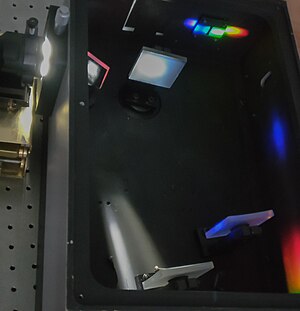This article includes a list of general references, but it lacks sufficient corresponding inline citations. (December 2010) |


An optical spectrometer (spectrophotometer, spectrograph or spectroscope) is an instrument used to measure properties of light over a specific portion of the electromagnetic spectrum, typically used in spectroscopic analysis to identify materials.[1] The variable measured is most often the irradiance of the light but could also, for instance, be the polarization state. The independent variable is usually the wavelength of the light or a closely derived physical quantity, such as the corresponding wavenumber or the photon energy, in units of measurement such as centimeters, reciprocal centimeters, or electron volts, respectively.
A spectrometer is used in spectroscopy for producing spectral lines and measuring their wavelengths and intensities. Spectrometers may operate over a wide range of non-optical wavelengths, from gamma rays and X-rays into the far infrared. If the instrument is designed to measure the spectrum on an absolute scale rather than a relative one, then it is typically called a spectrophotometer. The majority of spectrophotometers are used in spectral regions near the visible spectrum.
A spectrometer that is calibrated for measurement of the incident optical power is called a spectroradiometer.[2]
In general, any particular instrument will operate over a small portion of this total range because of the different techniques used to measure different portions of the spectrum. Below optical frequencies (that is, at microwave and radio frequencies), the spectrum analyzer is a closely related electronic device.
Spectrometers are used in many fields. For example, they are used in astronomy to analyze the radiation from objects and deduce their chemical composition. The spectrometer uses a prism or a grating to spread the light into a spectrum. This allows astronomers to detect many of the chemical elements by their characteristic spectral lines. These lines are named for the elements which cause them, such as the hydrogen alpha, beta, and gamma lines. A glowing object will show bright spectral lines. Dark lines are made by absorption, for example by light passing through a gas cloud, and these absorption lines can also identify chemical compounds. Much of our knowledge of the chemical makeup of the universe comes from spectra.
- ^ Butler, L. R. P.; Laqua, K. (1995). "Nomenclature, symbols, units and their usage in spectrochemical analysis-IX. Instrumentation for the spectral dispersion and isolation of optical radiation (IUPAC Recommendations 1995)". Pure Appl. Chem. 67 (10): 1725–1744. doi:10.1351/pac199567101725. S2CID 94991425.
A spectrometer is the general term for describing a combination of spectral apparatus with one or more detectors to measure the intensity of one or more spectral bands.
- ^ Schneider, T.; Young, R.; Bergen, T.; Dam-Hansen, C; Goodman, T.; Jordan, W.; Lee, D.-H; Okura, T.; Sperfeld, P.; Thorseth, A; Zong, Y. (2022). CIE 250:2022 Spectroradiometric Measurement of Optical Radiation Sources. Vienna: CIE - International Commission on Illumination. ISBN 978-3-902842-23-7.